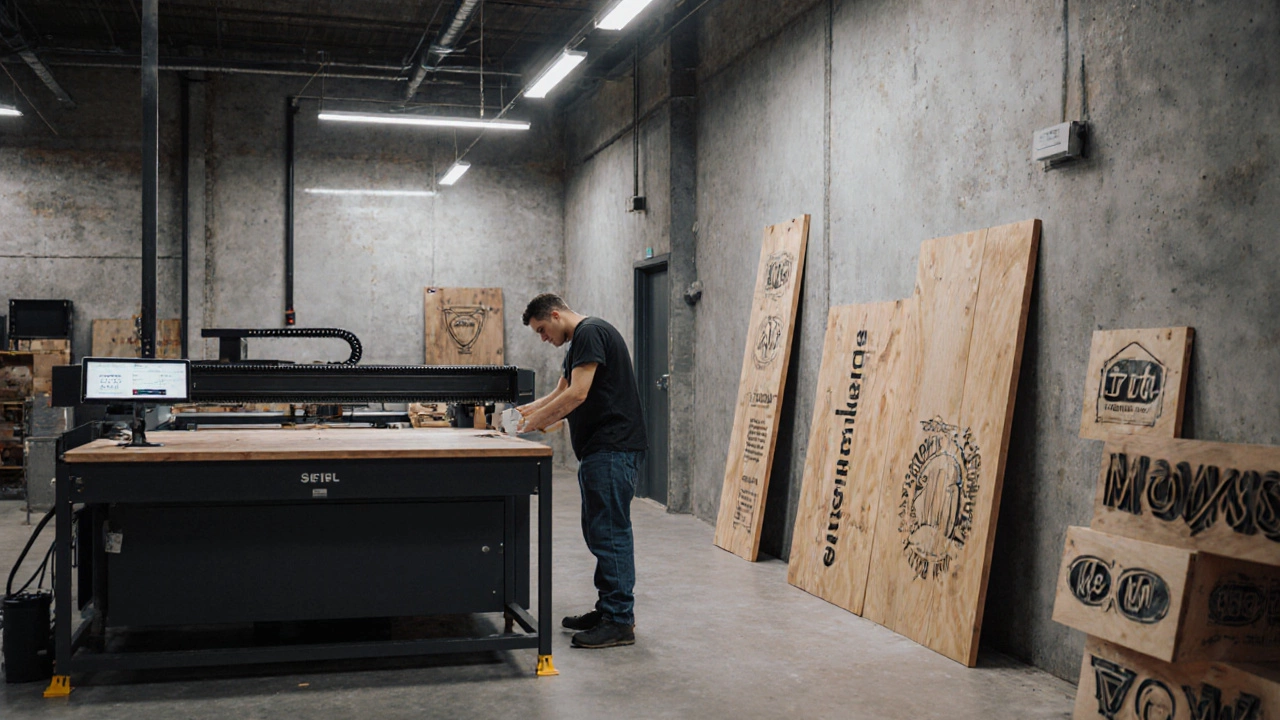Small Scale Production Qualifier
Determine if your manufacturing business qualifies as small scale production according to UK/EU standards. This tool uses the official criteria from the Office for National Statistics and European Union definitions.
Small scale manufacturers typically have fewer than 50 employees and an annual turnover under £10 million (or €10 million).
When you hear the word "manufacturing," you might picture huge factories with rows of robots, conveyor belts humming, and trucks loading up thousands of units every hour. But that’s not the whole story. Across the UK, in garages, converted warehouses, and quiet industrial parks, thousands of small operations are making real products - from handmade soaps to custom bike frames, from locally brewed cider to printed circuit boards for medical devices. So what exactly counts as small scale production? It’s not just about how many people work there or how big the building is. It’s about output, investment, and how the business fits into the wider economy.
There’s No Single Number - But There Are Guidelines
There’s no universal number that says, "This is small scale, and that’s not." Different countries, agencies, and industries use different thresholds. In the UK, the Office for National Statistics (ONS) defines small enterprises as those with fewer than 50 employees. For manufacturing specifically, the European Union’s definition - which the UK still often references - says small-scale manufacturing businesses have fewer than 50 employees and an annual turnover under €10 million or a balance sheet total under €10 million. That’s not a hard line, but it’s a practical starting point.
But here’s the thing: a business making 200 units a week could be small scale - or it could be a mid-sized operation if each unit sells for £500. A pottery studio making 10 hand-thrown mugs a day might be small scale. A company cranking out 10,000 custom phone cases a month using automated presses might still be small scale if it’s owned by one person and operates out of a 2,000-square-foot unit. The scale isn’t just about volume. It’s about control, resources, and how the business is structured.
What Small Scale Production Actually Looks Like
Think about a bakery in Liverpool that makes sourdough loaves in batches of 150 every morning. They use a single oven, two part-time bakers, and sell mostly at the local farmers’ market. That’s small scale production. They don’t have a distribution network. They don’t need a warehouse. They don’t have a marketing team. They make what they can sell, and they adjust based on feedback.
Or take a local electronics repair shop in Manchester that builds custom circuit boards for vintage audio gear. They order components in small quantities, hand-solder each board, and test them one by one. They might make 30 units a month. No assembly line. No quality control inspectors. Just one technician with a soldering iron and a passion for old radios. That’s small scale too.
Even in high-tech fields, small scale exists. A startup in Bristol designing wearable health monitors might produce 50 prototypes a quarter. They use 3D printers, laser cutters, and hand-assembled components. They’re not mass-producing - they’re validating, iterating, testing. That’s still manufacturing. Just on a human scale.
Key Characteristics of Small Scale Production
Small scale production isn’t just about size - it’s about how it’s done. Here are the common traits:
- Low capital investment: No million-pound machinery. Think benchtop CNC machines, manual lathes, or even hand tools.
- Flexible workflows: Lines can be reconfigured in hours, not weeks. One worker might handle five different tasks in a single day.
- Customization: Products are often made to order or in small batches with variations. No two runs are exactly the same.
- Local sourcing: Materials come from nearby suppliers. Lead times are short. No global logistics chains.
- Direct sales: Most products go straight to customers - online, at markets, or through local retailers. No middlemen.
Compare that to large-scale manufacturing: high automation, rigid production lines, long lead times, standardized products, and massive upfront costs. Small scale is the opposite. It’s agile, personal, and responsive.

Why the Line Matters - Government Support and Funding
Knowing what counts as small scale isn’t just academic. It affects who gets help. In the UK, small manufacturers can apply for grants through the Manufacturing Advisory Service, regional growth funds, or the Advanced Manufacturing Supply Chain Initiative. These programs are designed for businesses that can’t afford expensive consultants or expensive automation. If you’re classified as a large manufacturer, you’re shut out.
Take the case of a metal fabrication shop in Sheffield that makes custom brackets for local architects. They have eight employees and an annual turnover of £1.2 million. They qualify for government training grants because they’re classified as small. If they doubled their output next year, they’d still be small - unless they hit the €10 million turnover threshold. That’s the real boundary.
Many small manufacturers don’t even know they qualify for support. They think they’re too small to matter. But in reality, small scale production makes up over 90% of all UK manufacturing businesses. They’re the backbone of local economies.
Small Scale vs. Cottage Industry vs. Artisan
People often mix up terms. A cottage industry is usually home-based and often informal - think knitting sweaters in a living room. Artisan production focuses on craftsmanship and uniqueness - think hand-forged knives or small-batch cheese. Small scale production can include both, but it’s broader. It covers any business that manufactures goods in limited quantities with limited resources, regardless of where it’s located or how "handmade" it is.
For example, a company in Leeds that uses a CNC router to cut custom wooden signs from reclaimed timber is small scale manufacturing. The tool is automated, but the output is low, the team is small, and the materials are locally sourced. It’s not artisan in the traditional sense, but it’s still small scale.

When Small Scale Production Becomes Big
Many small manufacturers dream of growing. But growth can be dangerous. If you start scaling up too fast - hiring more staff, buying bigger machines, signing deals with big retailers - you lose the very things that made you successful: flexibility, control, and direct customer feedback.
Take a coffee roaster in Glasgow that started roasting 5kg batches in a converted garage. After three years, they were selling to 20 local cafes. They could have bought a 50kg roaster and gone national. Instead, they bought a second 5kg roaster and hired a second roaster. They doubled output without losing control. That’s smart scaling.
Real growth for small scale producers isn’t about volume - it’s about value. Better materials. Stronger branding. Deeper customer relationships. More consistent quality. Sometimes, staying small is the most profitable choice.
Technology Is Changing the Game
Don’t assume small scale means outdated. Today’s small manufacturers have tools that were once only available to giants. Desktop 3D printers, open-source CNC software, and online marketplaces like Etsy or Amazon Handmade have lowered the barrier to entry. A single person with a £2,000 laser cutter can now produce custom acrylic signs faster than a factory in China can ship them.
Platforms like Shopify and Printful let small makers handle fulfillment without warehousing. Digital design tools mean one person can prototype, test, and refine a product without hiring engineers. The rise of micro-factories - small, tech-enabled workshops - means you can now run a manufacturing business from a 1,000-square-foot unit with just two people.
That’s why small scale production is growing, not shrinking. It’s not about being old-fashioned. It’s about being smart.
Final Thought: It’s Not About Size - It’s About Control
Small scale production isn’t defined by how many units you make. It’s defined by who controls the process. If you’re making decisions about materials, pricing, design, and distribution - and you’re not answering to a corporate HQ or an investor board - you’re operating at a small scale. You’re not a cog in a machine. You’re the whole machine.
Whether you’re hand-stitching leather bags in your kitchen or running a 3D printing lab that makes prosthetic limbs for local hospitals, if you’re doing it with limited resources, direct customer contact, and personal oversight - you’re part of small scale manufacturing. And that’s something worth recognizing.
Is small scale production the same as handmade?
No. Handmade means the product is made entirely by hand, without machines. Small scale production can include machines - even automated ones - as long as the operation is small in size, investment, and output. A business using a CNC machine to make 50 custom parts a week is small scale, even if no hands touch the final product.
Can a business with 100 employees still be small scale?
Typically, no. In the UK and EU, small scale manufacturing is defined as having fewer than 50 employees. A company with 100 employees would be classified as medium-sized. However, some industries have looser definitions. If the business is still locally owned, uses low-tech equipment, and doesn’t have complex supply chains, some might still call it small scale informally - but officially, it’s not.
What’s the difference between small scale and micro manufacturing?
Micro manufacturing is a subset of small scale production. It refers to operations making extremely small quantities - often fewer than 100 units per month - and usually involves high-precision work like medical devices, microelectronics, or custom aerospace parts. Micro manufacturers often use specialized tools like laser micromachining or nano-printing. So all micro manufacturing is small scale, but not all small scale is micro.
Do small scale manufacturers get tax breaks in the UK?
Yes, but not automatically. Small manufacturers can qualify for R&D tax credits if they’re developing new products or improving processes. They can also access the Annual Investment Allowance, which lets them deduct the full cost of equipment up to £1 million in a single year. Local councils may offer business rate relief too. You need to apply - it doesn’t happen by default.
Can small scale production compete with big factories on price?
Not on price alone. Big factories win on cost-per-unit because of volume. But small scale producers win on uniqueness, speed, customization, and customer service. A customer will pay more for a hand-finished wooden table made to their exact dimensions than for a mass-produced one from a warehouse. Small scale competes on value, not volume.





